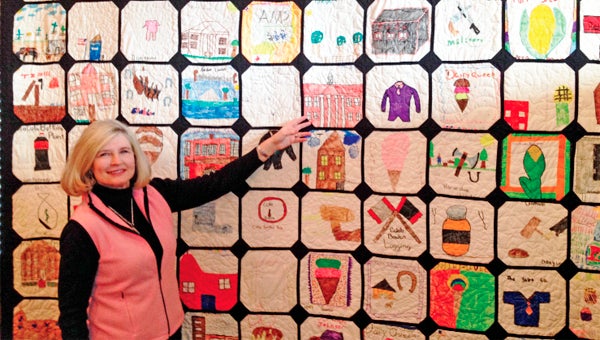Stitches in time
Published 12:00 am Wednesday, February 5, 2014

The idea for a quilt sparked with retired AMS teacher Linda Kyle. Here, she illustrates the size of the work.
It starts with a spark, an idea, and before long, something wonderful is created – be it a revolutionary leap in technology or a stunningly beautiful memento, as was the case as area students embraced the Smithsonian Exhibit’s theme “The Way We Worked.”
There are written tales of local residents, visual displays of local work processes and historic timelines of industry; however, one of the most visually impressive works currently on display at the Andalusia Chamber of Commerce is a 104-inch by 114-inch quilt. How it came into being is a tale of how the community, educators and students worked together to create a piece of history.
It started with an idea by quilter and retired Andalusia Middle School history teacher Linda Kyle last summer. A visit to Three Notch Quilt Shoppe and a casual conversation with its owner Sharon Hopkins put the plan into motion. Since then, the Shoppe has closed and moved its inventory to Pale Moon Yarns – which is where AMS teacher Jeff Walker, Kyle’s successor, and his wife, Louise, come into the picture.
“I thought it would be great to have students create a piece of history,” Kyle said. “And this is what they did. Isn’t it amazing?”
Walker agreed to have his sixth grade class create quilt squares of area workplaces, and the project was launched.
“These ladies had an awesome task putting this quilt together, and they did it beautifully,” Kyle said.
Hopkins, CCQG chairwoman, explained the process, which took a group of 111 students, eight ladies and countless hours to accomplish.
“There are actually 110 squares; we had to combine two,” she said. “But the students used permanent fabric markers because they don’t bleed, like a regular Sharpie. We then had to decide on the size, if we had as many blocks as kids, how big would it be? We told everyone it was going to be pretty big. We said that we could do two smaller quilts, but they said, ‘No, do one.’ Thankfully, there are high ceilings in the chamber.”
And the crew followed instructions to create the wall-sized quilt, Hopkins said.
While one group of ladies sewed the pieces, and another did the binding on the quilt, the quilting itself was done by Two Sisters Quilting.
“Norma Williamson and Miriam Foshee of Andalusia put it together,” Hopkins said. “And when it was all said and done, that quilt turned out huge and heavy. The weight of it, whew! They had to put up a drapery rod to hold it.”
There are four days remaining to view the quilt – and the corresponding Smithsonian exhibit before it closes on Saturday.
But, what happens to the quilt after the exhibit closes?
“That is the magic question,” Hopkins said. “I’ve asked Barbara Tyler at the city, and she said people are fighting over wanting to display it. She mentioned city hall and the elementary school. I don’t know. Once we made it and handed it over to them, it became up to them.”





